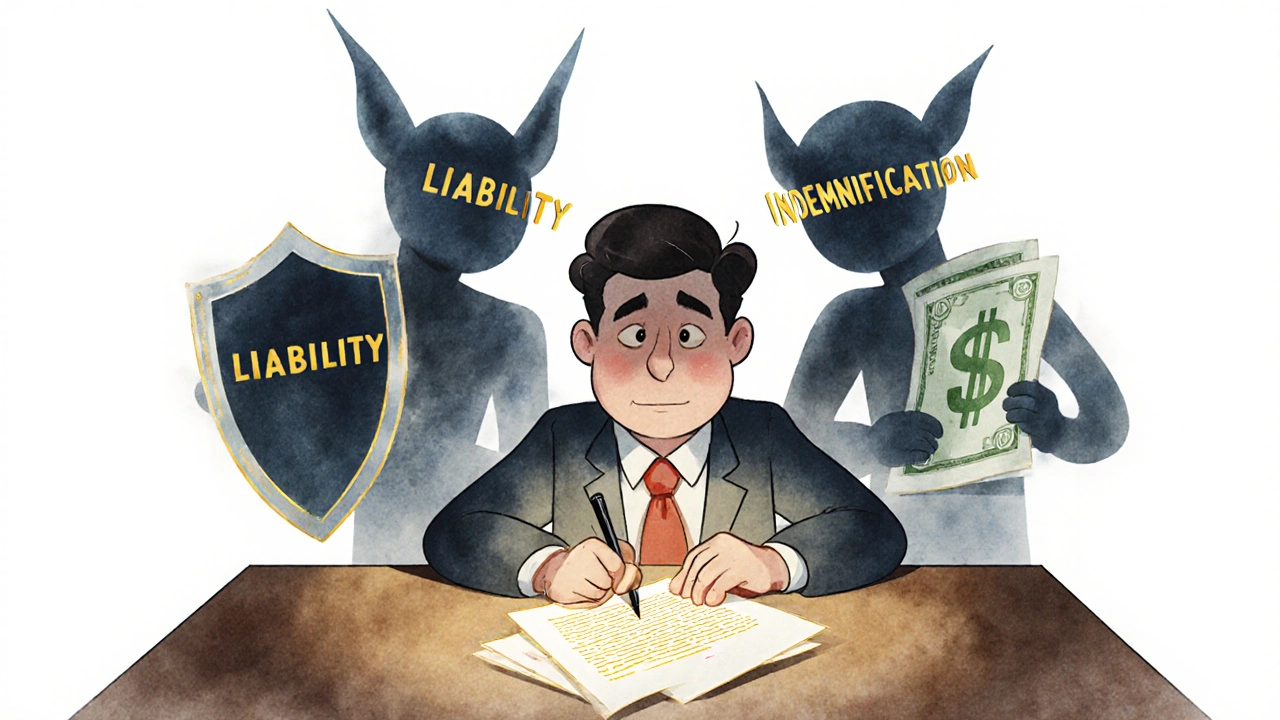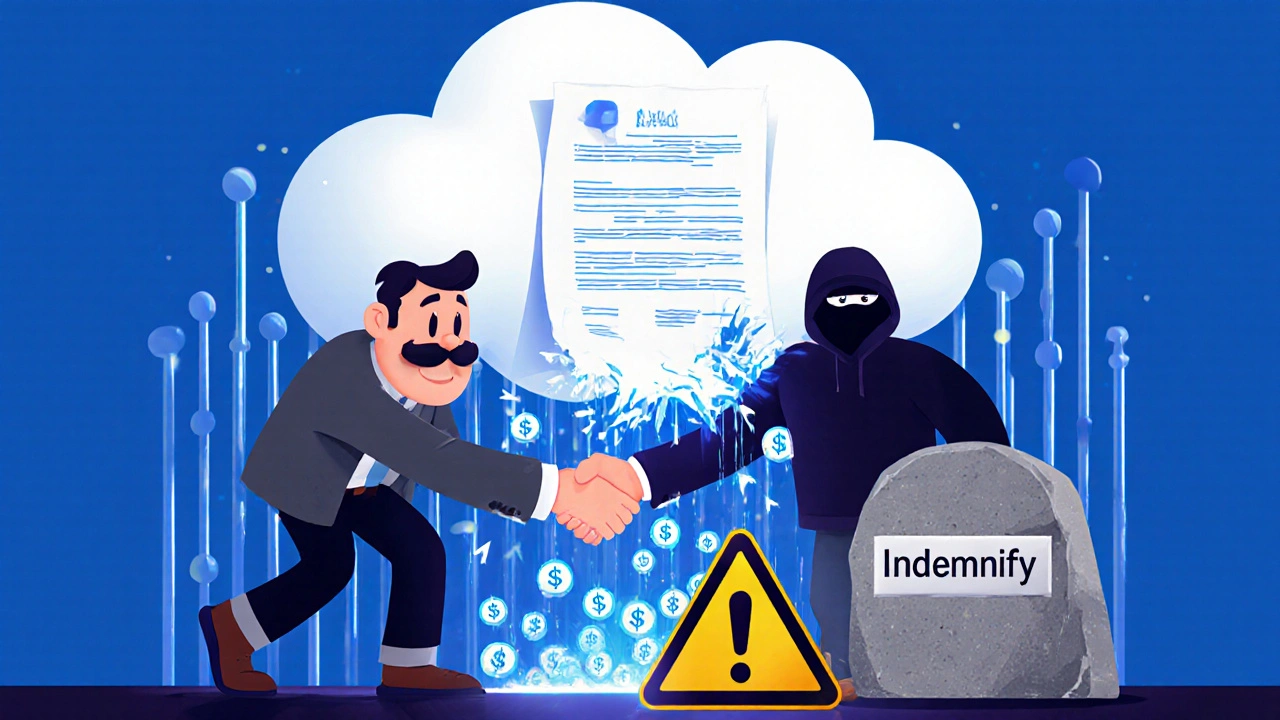Liability and Indemnification in Generic Transactions: What You Need to Know

When you sign a contract - whether it’s for software, a service, a product, or even a simple service agreement - you’re not just agreeing to pay or deliver something. You’re also agreeing to take on risk. And that risk? It’s often managed through two legal tools: liability and indemnification. Most people don’t read these parts of a contract. They should.
Imagine you’re a small business buying a cloud-based inventory system. The vendor promises it’s secure. Six months later, a hacker breaks in. Customer data is stolen. Your company gets sued. Who pays for the legal fees? The fines? The notification letters to customers? If the contract doesn’t clearly say who’s on the hook, you’re stuck footing the bill. That’s where indemnification comes in. It’s not magic. It’s just a written promise: if this bad thing happens because of you, I’ll cover it.
What Indemnification Actually Means (No Legalese)
Indemnification is a contract clause that says one party will pay for losses the other party suffers because of something specific. It’s not a guarantee that nothing bad will happen. It’s a promise that if something bad does happen, one side will pay the other back.
Think of it like car insurance. You don’t expect to crash. But if you do, the insurer pays for repairs. Indemnification works the same way - except the insurer is the other party in your contract.
Here’s how it breaks down in plain terms:
- To indemnify = Pay for losses (like legal bills, fines, or settlements)
- To defend = Pay for lawyers and court costs if someone sues
- To hold harmless = Promise not to sue back if the other party gets sued because of your actions
These three terms are often bundled together in contracts - “indemnify, defend, and hold harmless.” But legally, they’re not the same. A court in California made this clear in 2008: “Indemnify” means pay for losses. “Defend” means pay for legal costs. “Hold harmless” means don’t turn around and sue. Mixing them up can cost you.
What Triggers Indemnification?
Not every problem triggers payment. The contract has to say exactly what does. Common triggers include:
- Breaching a promise you made in the contract (like saying your software doesn’t violate copyrights)
- Breaking the law (like failing to protect personal data under privacy rules)
- Causing harm to a third party (like a customer getting injured by your product)
- Failing to get required permits or licenses
Example: A software company sells a payment processing tool to an online store. The contract says the vendor will indemnify the buyer if the software causes a data breach. A hacker exploits a known flaw the vendor never patched. The online store gets hit with a $200,000 fine from regulators. The vendor is on the hook - because the trigger (a breach caused by their software) happened.
But if the breach happened because the store’s employee used a weak password? That’s on the buyer. The vendor doesn’t pay unless the contract says otherwise.
Who Pays? Mutual vs. One-Sided
Not all indemnification is equal. There are two main types:
- Unilateral: One party pays for the other’s losses. Common in vendor-buyer deals. Example: A big retailer demands a supplier indemnify them if the product causes injury. The supplier has little power to refuse.
- Mutual: Both sides protect each other. Common in joint ventures, construction contracts, or partnerships. Example: Two companies building a shared warehouse agree to cover each other’s costs if a subcontractor gets hurt on site.
Unilateral indemnification is far more common. Buyers - especially big ones - almost always demand it. Sellers? They hate it. But if they want the deal, they sign.
Here’s the reality: If you’re the seller, you’re almost always the one paying. That’s why sellers fight hard to limit it.
The Hidden Rules: Caps, Deductibles, and Survival Periods
Indemnification isn’t unlimited. Smart contracts put guards on it. Three big ones:
- Cap - The maximum amount the indemnifier will pay. Example: “Seller’s total liability capped at 100% of the purchase price.”
- Deductible (or Basket) - The amount of loss the buyer must absorb before the seller pays. Example: “Seller only pays if losses exceed $50,000.”
- Survival Period - How long after closing the indemnification lasts. Example: “Fundamental reps survive 3 years; all others survive 18 months.”
“Fundamental representations” are the big ones: ownership of assets, authority to sign the contract, no hidden debts. These usually last longer because they’re core to the deal. “Non-fundamental” ones - like employee benefits or IP licenses - are more routine and have shorter survival times.
Why does this matter? If you’re buying a business and find a tax error three years later, you can only claim indemnification if the seller’s promise about taxes was a fundamental rep - and if the survival period hasn’t expired.

Insurance: The Safety Net No One Talks About
What if the company promising to pay you goes bankrupt? Or just refuses to pay? That’s where insurance comes in.
Good contracts require the indemnifying party to carry insurance - like errors and omissions (E&O) or general liability - that covers indemnification claims. The contract will say:
- What type of policy is required
- Minimum coverage amount (e.g., $2 million)
- Whether the policy must name the other party as an additional insured
Without this clause, indemnification is just a piece of paper. If the vendor has no insurance and no cash, you’re out of luck. Always check this part. Don’t assume they’re covered.
What Happens When a Claim Is Made?
Indemnification isn’t automatic. There’s a process.
Most contracts require the party seeking payment to:
- Notify the other side in writing within 30 days of learning about the claim
- Provide all documents and evidence
- Let the indemnifying party control the defense (if they choose to)
Control of the defense is a big deal. If the vendor controls the legal team, they might settle fast to keep costs low - even if you think you’re not at fault. If you control it, you might drag it out and rack up legal bills. The contract should say who gets to choose the lawyers.
Pro tip: If the indemnifying party refuses to defend, you can hire your own lawyer - and then bill them. But only if the contract allows it. Many don’t. Read the fine print.
Why This Matters in Real Life
Let’s say you’re a startup selling AI tools to schools. You sign a contract with a school district. The contract says you’ll indemnify them if your tool violates student privacy laws.
You assume your software is fine. But you didn’t check if it stores names with student IDs - which under Australian law (and GDPR) counts as personal data. A parent sues the school. The school turns to you for indemnification.
Now you’re on the hook for legal fees, fines, and maybe even a settlement. If your contract had a $100,000 cap and a $25,000 deductible, you’d pay $75,000. If it had no cap? You could be bankrupted.
This isn’t hypothetical. In 2024, a Melbourne-based EdTech company paid over $320,000 after a similar clause triggered. They hadn’t reviewed their indemnification language in three years. The buyer had.

How to Protect Yourself
If you’re buying:
- Push for broad indemnification - cover breaches, third-party claims, and regulatory fines
- Require insurance and ask for proof
- Set a high cap or no cap for fundamental breaches
- Make sure the survival period lasts long enough to catch hidden issues
If you’re selling:
- Limit indemnification to only what’s truly your fault
- Insist on a deductible and a cap (e.g., 50-100% of the contract value)
- Shorten survival periods for non-fundamental reps
- Exclude indirect damages (like lost profits or reputational harm)
- Never agree to “hold harmless” for the buyer’s own negligence
And always - always - get a lawyer to review this section. Don’t rely on templates. Every deal is different.
Common Mistakes That Cost People Money
- Assuming “indemnify” means “defend” - they’re not the same
- Not checking insurance requirements - leaving yourself exposed
- Signing a mutual indemnification without understanding the risks - you might end up paying for your own mistakes
- Forgetting survival periods - missing the window to claim
- Letting the other side control your defense - they might settle badly
One client of mine - a logistics company - signed a contract with no indemnification cap. A driver they hired caused an accident. The client got sued for $1.2 million. The contract said the logistics company had to pay. They lost their entire business.
Final Thought: It’s About Risk, Not Blame
Indemnification isn’t about who’s right or wrong. It’s about who agreed to pay if things go sideways. The goal isn’t to avoid risk - it’s to assign it clearly before the deal starts.
Whether you’re buying a SaaS tool, hiring a contractor, or selling a business - if the contract doesn’t spell out liability and indemnification, you’re gambling. And in business, gambling is the one thing you can’t afford.
Read the clause. Understand the triggers. Know the limits. And never sign without knowing what you’re promising to pay for.
Is indemnification the same as insurance?
No. Indemnification is a promise in a contract to pay for losses. Insurance is a policy from a company that pays out if certain events happen. Indemnification can be backed by insurance, but it doesn’t have to be. Without insurance, the party promising to pay must have the money to do it - or they’ll default.
Can I get out of an indemnification clause after signing?
Generally, no. Once you sign a contract, you’re legally bound to its terms - including indemnification. You can try to negotiate changes before signing, but after? Only if the other party agrees to amend it in writing. Courts almost always enforce signed indemnity clauses unless they’re illegal or grossly unfair.
What’s the difference between a cap and a deductible in indemnification?
A cap is the maximum amount the indemnifying party will ever pay - no matter how big the loss. A deductible is the minimum amount the other party must absorb before the indemnifying party starts paying. Example: $100,000 cap, $25,000 deductible. If losses are $80,000, the indemnifying party pays $55,000. If losses are $150,000, they pay $100,000 (the cap).
Do indemnification clauses work in all countries?
Most countries recognize indemnification, but how they enforce it varies. In Australia, courts generally uphold clear, unambiguous clauses. In some U.S. states, indemnification for your own negligence is void unless explicitly stated. Always include a governing law clause - e.g., “This agreement is governed by the laws of Victoria, Australia” - to avoid confusion.
Should I ever agree to indemnify someone for their own mistakes?
Never. A true indemnification clause should only cover losses caused by your actions, not the other party’s negligence. If a contract says you’ll indemnify them for “any claim arising from their use of the product,” that’s dangerous. Push back. Demand it be limited to “claims arising from breach of this agreement or your negligence.”
